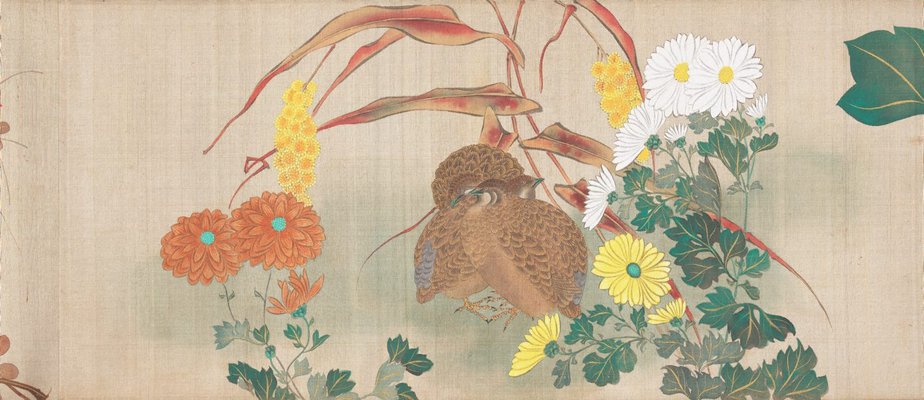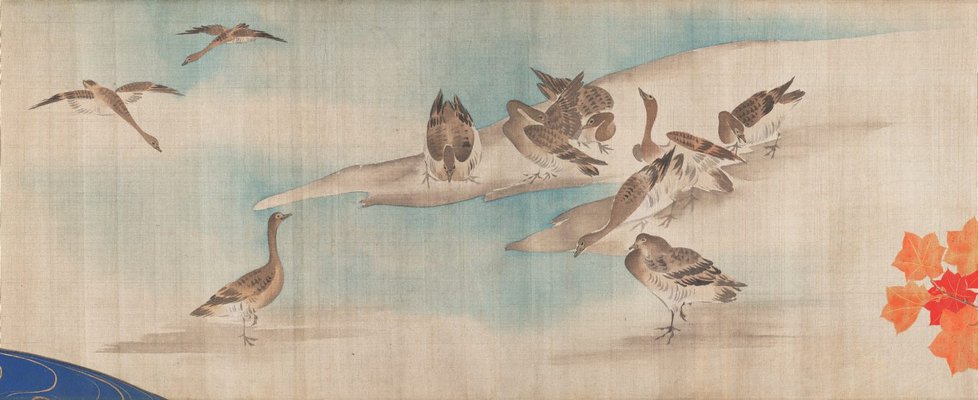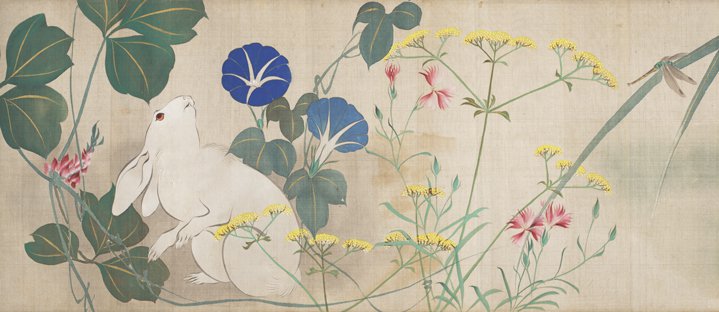





-
Details
- Place where the work was made
-
Japan
- Date
- 1850-1900
- Media categories
- Scroll , Painting
- Materials used
- handscroll; ink and colour on silk
- Dimensions
- 26.8 x 348.6 cm
- Credit
- Purchased with funds provided by W Schmidlin and D Apelbaum and the Asian Art Collection Benefactors 2014
- Location
- Not on display
- Accession number
- 157.2014
- Copyright
- Artist information
-
Nozaki Shin'ichi
Works in the collection
- Share
-
-
About
Shin’ichi’s scroll opens with a scenery of late summer in which small insects such as cricket, praying mantis, grasshoppers and firefly gather around stalks of susuki grass, and progresses through various autumnal scenes involving a white rabbit amidst a field of patrinia, bush clover, pinks and evening glories; a group of three quails huddled together among shrubs of chrysanthemums and millet stalks and horned owl, encircled by sparrows and other small birds resting on branches of a red maple tree. A flock of wild geese on a sand bank heralds the transition from autumn to winter, represented by the pair of mandarin ducks at the shore of a meandering stream. The artist seems to favour autumn over the other seasons, dedicating three scenes to this most colourful time of the year while spring is completely omitted in this composition. The use of brilliant pigments, careful and delicate brushwork and skilfully employed ‘pooled ink’ technique (‘tarashikomi’) to suggest three-dimensionality show the strong influence of Hōitsu.
While flora and fauna are rendered in a naturalistic manner, which is characteristic feature of Edo Rinpa style, Shin’ichi also succeeds in adding a sense of humour in his work, most notably in the depiction of the white rabbit. Traditionally, rabbits are associated with the legendary hare who resides in the moon where he pounds the elixir of immortality. In the early 17th century, Japanese artists extended the association with the moon to the autumn season, in which the moon is said to be most beautiful. Images of rabbits among autumn flowers and grasses began to emerge in paintings and decorative art, especially in the work of Rinpa artists. In Shin’ichi version, the rabbit is shown amongst typical autumnal flowers with its head turning to look over its shoulder at an autumn moon somewhere beyond the pictorial frame. Endearing and ample of lyricism and suggestiveness, this scene certainly stands out in this overall very attractive handscroll. Another, rather unusual motif in the depictions of flowers and birds of the four seasons is the horned owl perching on a wooden stand below red maple leaves. This subject was introduced to the Rinpa repertoire by Hōitsu in the late 18th century.
Nozaki Shin’ichi is the oldest son of Ishigaki Hōshin (1790-1856), who studied painting with Sakai Hōitsu. In the compendium of painting and calligraphy (Shoga kaisui) of 1832, it is recorded that Shin’ichi started his career as a painter in that year after having retired from government services and taking the 'tonsure' at the Imado Hachimangu in Edo. Even though Shin’ichi never studied directly with Hōitsu, he earned the accolade of being the artist who most truthfully followed the renowned master’s style and successfully transmitted it into the Meiji period (1868-1912). -
Places
Where the work was made
Japan
-
Exhibition history
Shown in 1 exhibition
Conversations through the Asian collections, Art Gallery of New South Wales, Sydney, 25 Oct 2014–13 Mar 2016
-
Bibliography
Referenced in 5 publications
-
Lisa-Marie Murphy, Look, 'Building the Gallery's collection', pg. 33-34, Sydney, Mar 2015, 34 (colour illus.).
-
Mito Nobue, Rimpa-Kawaii! Engaging Japanese Art, Japan, 2014, 123-128 (colour illis.), 128 (colur illus.). All images are details of the work
-
Justin Paton, Look, 'Conversations. A new way to engage with the Gallery's Asian art', pg. 22-23, Sydney, Oct 2014, 22-23 (colour illus.).
-
John Saxby, Look, "Cressida Campbell. The art that made me' Interview, pg. 12-13, Sydney, Jun 2015, 13 (colour illus). Image is detail only
-
Tadashi Kobayashi (Editor), Rimpa Painting. Vol. V, Assorted themes, Tokyo, 1992, 242-243.
-
